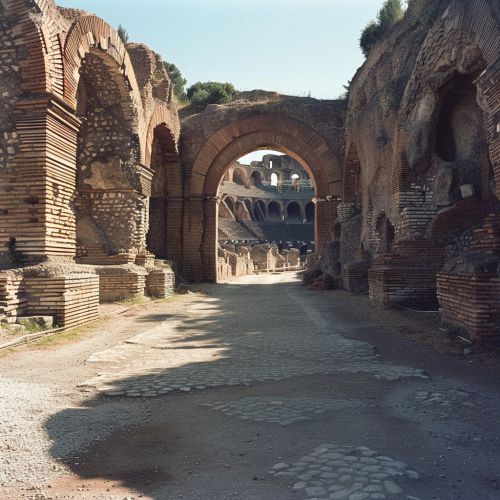Vomitorium
Definition
A vomitorium is a passage situated below or behind a tier of seats in an amphitheatre or a stadium, through which big crowds can exit rapidly at the end of a performance. They can also be pathways for actors to enter and leave stage. The Latin word 'vomitorium', plural 'vomitoria', derives from the verb 'vomo, vomere', meaning 'to spew forth'. Despite the name, vomitoria were not designed for the purpose of actual vomiting.
Etymology
The term 'vomitorium' is derived from the Latin verb 'vomo, vomere', which means 'to spew forth'. This term was used to describe the way that these passages would 'spew forth' crowds of people after a performance. The plural form of the word is 'vomitoria'. The word has been in use since at least the 4th century AD, when it was mentioned in the 'De Architectura' by the Roman architect Vitruvius.
Design and Function
Vomitoria were designed to allow large crowds to exit a venue quickly and efficiently. They were typically located below or behind the seating areas, and were wide enough to accommodate several people at once. This design allowed for the rapid dispersal of people, reducing the risk of crowding and stampedes. In addition to serving as exit passages, vomitoria were also used as entrances for actors. This allowed for quick and dramatic entrances and exits, which were an important part of many performances.


Historical Context
Vomitoria were a common feature in large public buildings in ancient Rome, including theatres, amphitheatres, and stadiums. They were an essential part of the design of these buildings, allowing for the efficient movement of large crowds. The most famous example of a building with vomitoria is the Colosseum in Rome, which had 80 vomitoria and could seat up to 50,000 spectators. Other notable examples include the Theatre of Pompey and the Circus Maximus.
Modern Usage
While vomitoria are most commonly associated with ancient Rome, the concept has been used in the design of modern stadiums and theatres. Modern vomitoria are typically located at the base of seating sections, allowing spectators to quickly enter and exit the seating area. They are an important part of crowd control strategies, helping to prevent overcrowding and ensure the safety of spectators. Examples of modern stadiums with vomitoria include the Camp Nou in Barcelona and the Michigan Stadium in the United States.
Misconceptions
Despite the name, vomitoria were not designed for the purpose of actual vomiting. This is a common misconception, likely stemming from the Latin root of the word, 'vomo', which means 'to spew forth'. In reality, the term refers to the way that these passages 'spew forth' crowds of people, not to any sort of bodily function. This misconception has been perpetuated in popular culture, but is not supported by historical evidence.
